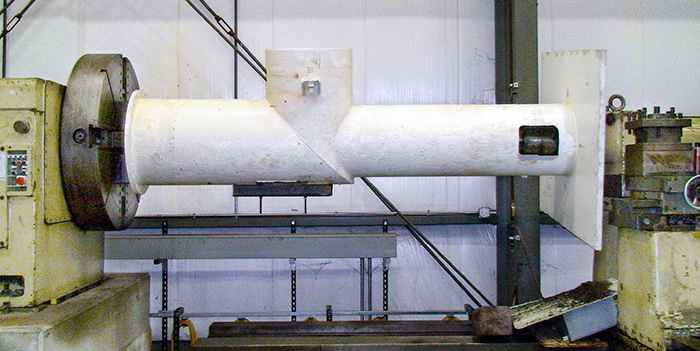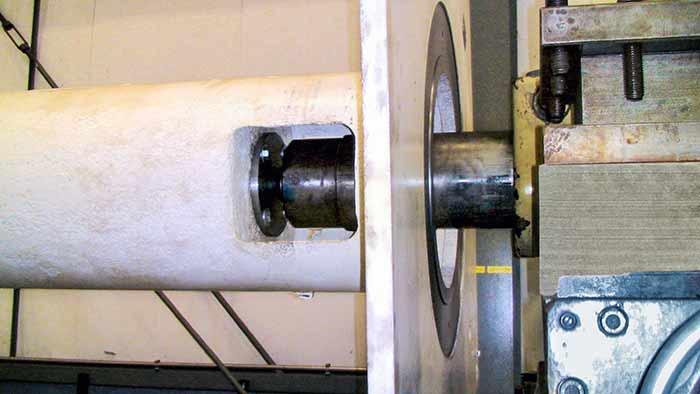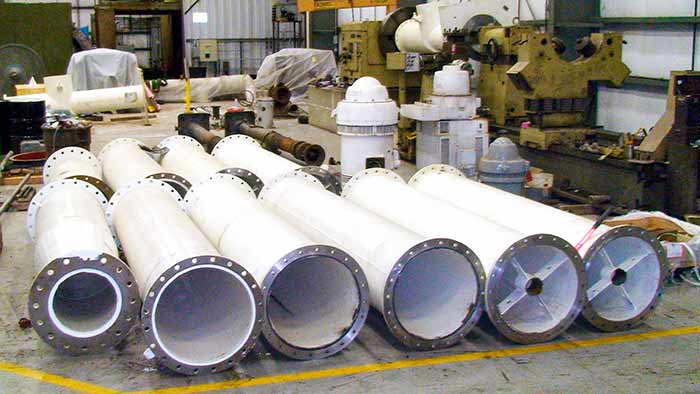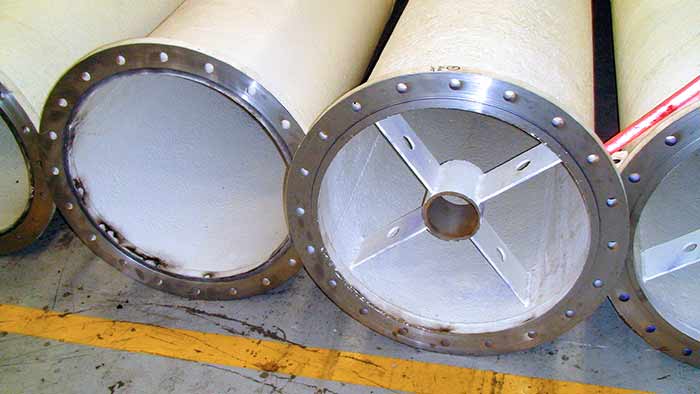Vertical turbine pumps (VTPs) are workhorses in the petrochemical, power generation and manufacturing industries, and prolific in municipal water applications that handle the primary intake load. The ability to develop high head with multiple impeller bowls—coupled with the ubiquity of standard vertical motors that can support heavy pump shaft loads—makes VTPs a good choice. Although these machines are ruggedly built, abrasive sediments in the pumpage take a toll, particularly on line shaft and pump bowl bearings, so periodic overhauls are often necessary. Rather than simply replacing the bearings, however, it is important that repairs address all of the issues needed to restore maximum operating life.
Common Repairs
Common VTP repairs include replacing line shaft and pump bowl bearings, replacing worn shafting, removing corrosion from submerged components and applying corrosion-resistant coatings. Corroded or cavitation-damaged impellers may be repaired and coated or, if badly damaged, replaced.
Pump bowls, suction bells and discharge casings are typically heavy castings that can be reconditioned and fitted with replacement wear rings as necessary. Column sections are similarly reconditioned or replaced if severely corroded.
The discharge elbow that supports the pump (mounted below) and the motor (mounted above) may be less affected by corrosion than submerged components, but special attention is needed to identify and correct any distortion that may have resulted from the heavy stresses applied to this component.
Fit & Alignment
Since line shaft and pump bowl bearings are the most common wear parts for VTPs, repairs should address the fit and alignment of these components. If the discharge elbow and column sections have become distorted, simply replacing the worn bearings will not restore proper running clearances. In that case, the faces and rabbits of the mating components must also be remachined to restore dimensional integrity. Unless special manufacturing equipment is available, this challenging task requires a lathe or boring mill large enough to handle the bulky pump components, and possibly careful engineering to properly support them in the machine tool.
 Image 1. Discharge elbow with motor pedestal flange mounted in lathe (Images courtesy of EASA)
Image 1. Discharge elbow with motor pedestal flange mounted in lathe (Images courtesy of EASA)Image 1 shows a large discharge elbow mounted in a lathe where the column section rabbit and motor pedestal flange have been remachined. Note that some of the specially engineered features required to properly support the discharge elbow in the lathe:
- The lathe live tail stock supports the elbow at the upper bearing and seal housing. A special adapter was machined to fit the housing mount.
- To provide clearance for machining the face and rabbit, bracing was welded into the lower end of the elbow where it is chucked to the headstock.
- A counterweight was installed on the outside of the elbow (opposite the discharge nozzle) to control rotational pitching.
 Image 2. Remachined motor pedestal flange in the lathe
Image 2. Remachined motor pedestal flange in the latheFacing the mounting flanges on the elbow and column sections is a straightforward machining process (once the mounting accommodations have been engineered). If the rabbit outer diameter (OD) and inner diameter (ID) fits are within tolerance, remachining is not necessary. However, if they are distorted or corroded, a refitting process is required to correct the rabbit fits. One method of repair is to machine the male rabbit to a female configuration and install a female-to-female “gender mender” ring. The ring may be secured to the proper column section with recessed cap screws. Images 3 and 4 show column sections that have been refaced.
 Image 3. Refaced column sections
Image 3. Refaced column sectionsBearing-to-Shaft Clearances
A key element of a VTP repair is to machine replacement bearings to the proper shaft clearances. The hydrodynamics of vertical bearings are quite different than for horizontal machines, and clearance specifications vary significantly among pump manufacturers, most of whom specify a range for bearing clearances. Tighter clearances reduce shaft whip and resulting wear but require the shafting and couplings to be free of excessive runout, and the bearings to be concentric up and down the column and bowls. Thus, the machine work to true up the flanges and rabbits allows tighter bearing clearances, improving the longevity of the bearings.
 Image 4. Close-up view of refaced column sections
Image 4. Close-up view of refaced column sectionsAttempting to fix bearings that are not concentric up and down the column and bowls by opening up bearing clearances is not a good practice. Although larger clearances may allow free shaft rotation, they also can increase shaft whip and accelerate wear.
Primary Repair Concerns
VTPs are heavy, rugged machines and generally not technically sophisticated. Some models have shaft enclosing tubes with various lubrication schemes that add complexity, but the primary repair concerns are the dimensional integrity of the major components, the straightness of the shafting and the clearance for the column and bowl bearings. Other concerns include selection of bearing material, impeller balancing and cleaning-recoating for corrosion resistance.
The removal and re-installation expenses for VTPs can be significant for long-set pumps that must be disassembled and reassembled on-site. Proper repair engineering, techniques and attention to dimensional integrity pay dividends in extended operational life for the machine.


